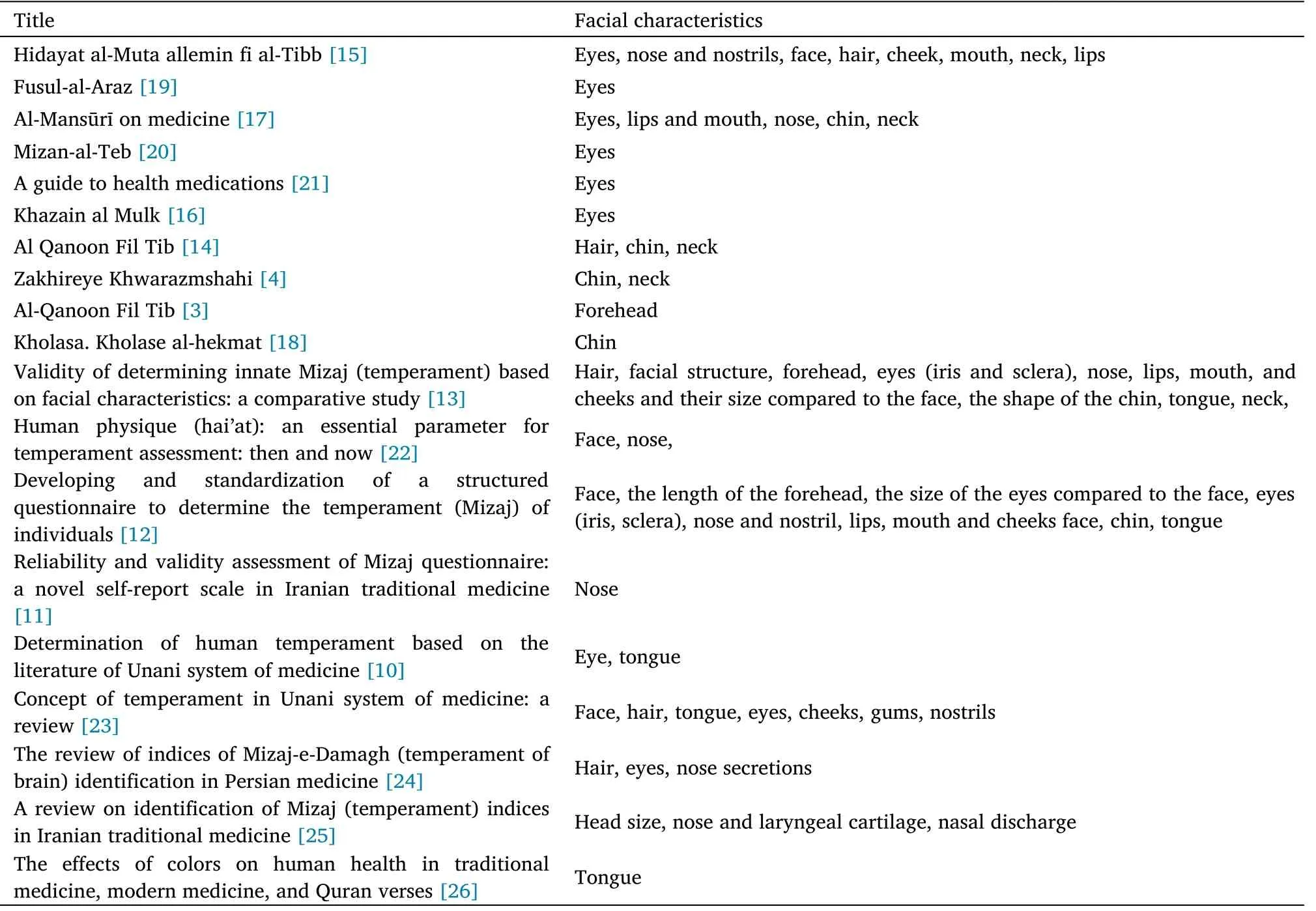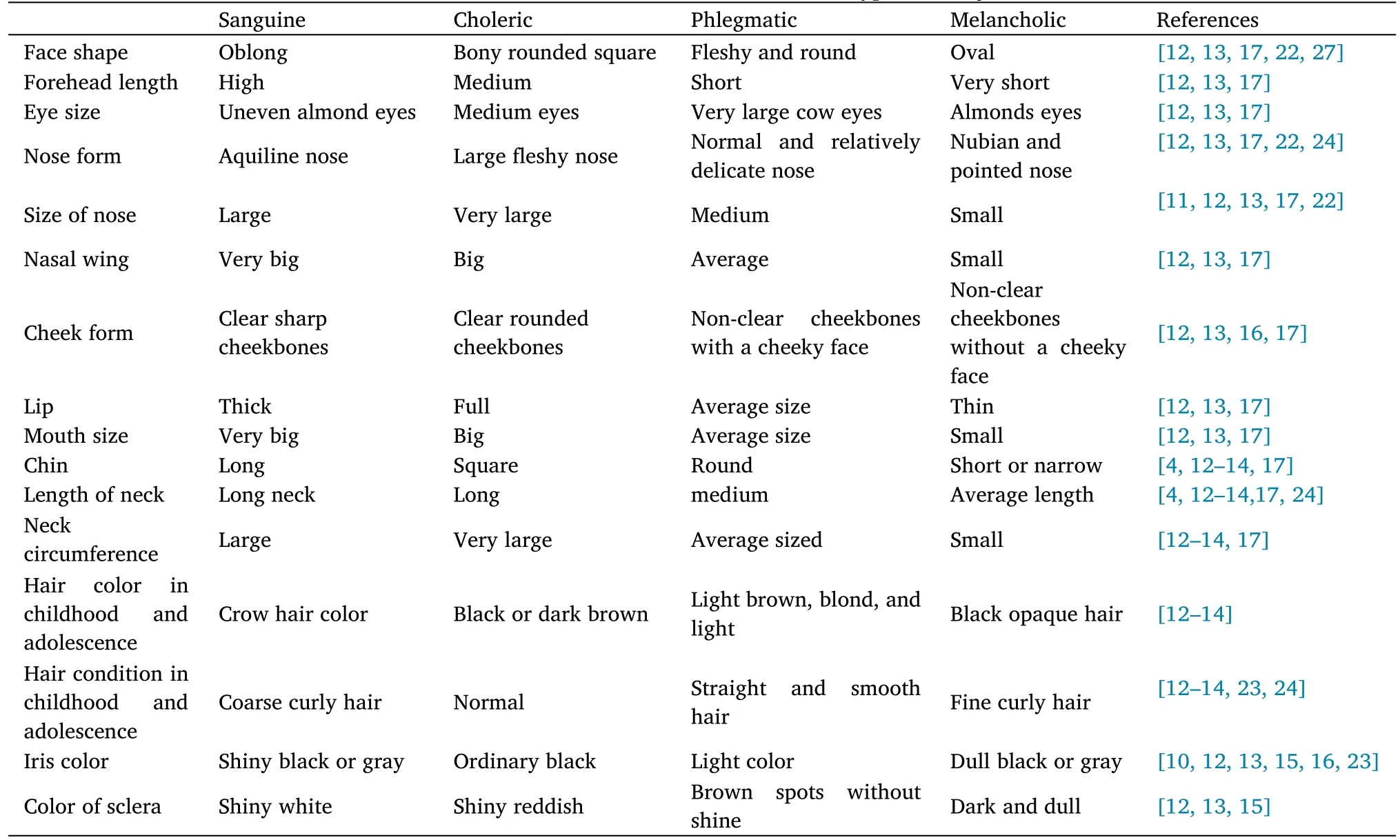Facial characteristics and Mizaj
Background
Iranian traditional medicine, originating from Greek medicine, is based on the four elements theory, which defines the origin of life as the composition of the four elements of air, soil, fire, and water [1, 2].According to Iranian traditional medicine, actions and reactions of opposite qualities of these four elements and interaction among“themselves by virtue of their respective powers(qualities)”in varying amounts of these combinations form the unique Mizaj (temperament)of each human being[3].
Each human being has a unique Mizaj based on the combination of the warmness of fire, the coldness of soil, the wetness of water, and the dryness of air [4, 5].The combinations of these elements are generally categorized as Sanguine Mizaj (warm and wet), Choleric(warm and dry), Phlegmatic (cold and wet), Sanguine Mizaj, and Melancholic Mizaj (cold and dry) [4–9].Mizaj is also categorized as innate and acquired.Each individual is born with the innate Mizaj,and the acquired type commonly results from living conditions and lifestyle[4, 5].
According to Iranian traditional medicine, health status is related to the balance of the combination of elements that exist in each individual’s Mizaj, and Mizaj plays a vital role in diagnosing and treating diseases [3].Therefore, the accurate identification of Mizaj of each person is very important.In ancient times, the physicians (which in ancient times were called Hakim)would identify the Mizaj based on their experience while considering various parameters, such as the color of the skin, hair, muscles and fat, touch, complexion, physique,functions and the state of body members.These are the main parameters mentioned by Galen, Rabban Tabri, Razi, Ali Ibn Abbas Majoosi, Jurjani, Ibn Rushd, and Arzani [10].
However, identifying Mizaj is challenging today for traditional medicine physicians, who may diagnose different Mizajs for one individual.Therefore, some attempts have been made to develop standard tools for the accurate diagnosis of Mizaj [11, 12].
Among all parameters used to diagnose Mizaj, facial characteristics play an essential role.According to some studies, facial characteristics alone can validly predict Mizaj [13].
This study aimed to review published articles and books to evaluate the effectiveness of facial characteristics on Mizaj diagnosis.
Methods
Therefore, this review was conducted to evaluate the role of facial characteristics in diagnosing the Mizaj of individuals based on published literature, including the original books of traditional medicine alongside scientific articles published in recent decades.
(33)吾聞渠家其貧,猒多子欲殺,吾難復人身矣。(《太上說玄天大聖真武本傳神呪妙經註》卷四,《中华道藏》30/560)
Search strategy
In case of underreporting the data or restriction of access to the article, the article was excluded from the study.
Eligibility criteria
The studies were included if they investigated or used the facial characteristics to diagnose Mizaj.For the traditional medicine books,those mentioning facial characteristics as Mizaj identification parameters were included.If the reviewed traditional medicine book was in Farsi, it should also have authors with authoritative sages of medical history, practical experience in medical work, and successfully published with acceptable eloquence.Gray literature,studies published in languages other than English or Persian, studies that only their abstracts were available and unfinished studies were excluded.Study type was not considered as the eligibility criteria.
Selection process for articles
First, the articles were reviewed and selected based on their title and abstracts, according to the inclusion criteria.Three categories,including “excluded”, “included”, or “probable” were defined.The articles that did not qualify for the study were excluded.The reviewer then examined the full text of the articles categorized as “probable”,and a list was prepared.The list was examined, and the disputes were assigned to the included or excluded category based on the vote of the second or third expert.
Data collection process
强化入海水道工程巡视检查,既是工程管理规程规范的要求,更是由入海水道工程自身特点和功能决定的。入海水道工程的特点主要有:
Study risk of bias assessment
A methodologist investigated all articles based on the international guidelines for reporting, such as consolidated standards of reporting trials, preferred reporting items for systematic reviews, and meta-analyses, strengthening the reporting of observational studies in epidemiology, and the articles with low validity were excluded.
在我国,书法作品被列为著作权法保护对象,最早可追溯到《大清著作权律》。我国现行著作权法也明确将其列为美术作品的一种形式予以保护,这在世界各国的著作权立法上是鲜见的。因此,对书法作品加以著作权保护,是极具有中国特色的立法,尤其对于毛笔书法而言更是如此。本文尝试结合毛笔书法的特性来探讨其著作权保护中的一些特殊问题。
Two independent reviewers conducted the eligibility and quality assessment.
稀土矿物主要有氟碳铈矿、氟碳钙铈矿。矿石中的稀土元素以轻稀土为主,主要为铈组元素的铈、镧、钕、镨等,有少量的重稀土钇。岩石中的主要化学成分为Ca,Mg,Fe,Si,P,CO2(表1);其次为TRE2O3,Al,Ba,Mn,Sr,Ti等;有很少量的Zr,Na,Nb,Cu,Pb,Ga等元素(表2)。矿石中TRE2O3含量0.75%~1.67%,平均1%。
Reporting bias assessment
In March 2022, international credible scholarly databases, including Google Scholar and PubMed, as well as Persian traditional medicine books, were searched.The references of selected articles were also hand searched for finding relevant studies.Islamic medicine software was used to obtain data related to Persian traditional medicine.The keywords used in both English and Persian search include“Mizaj”, “Mizaj identification”, “Mizaj determination”, “facial characteristics”, “nose”, “lips”, “chin”, “cheek”,“eyes” and“face”.
The included studies were reviewed for quality and validity, and those studies without quality and validity were excluded.For the final review, all selected articles were carefully studied, and the following data were extracted and entered in the information extraction form:title, type of study, aim,facial characteristic, and results of the study.
1) GB 50151—2010《泡沫灭火系统设计规范》规定从手动或自动启动消防泵到泡沫从喷射口喷出时间不大于5 min,调研国内油库该过程时间通常大于5 min甚至大于10 min的情形。研究表明储罐灭火最佳时机是火灾初期5~10 min。
Result
Table one shows the twenty-two studies and books of traditional medicine that applied facial characters to diagnose Mizaj.These studies included nine published peer review articles in scientific journals and thirteen books of traditional medicine.The facial characteristics used for diagnosing Mizaj include hair color during childhood and adolescence, the hair condition, the face shape, the length of the forehead, size and color of the eyes, the form and size of the nose, the shape of the nostrils, the form of cheek and chin, the size and form of the mouth and lips, the length and circumference of the neck (Table 1) [3, 4, 14–18].
Also, some studies emphasized that the face and nose are the two essential parameters of temperament assessment [22] (Table 2).


The size and form of the nose can also show a wet or dry Mizaj.Narrow nose, beautiful sharp point, and wide nostrils are seen in people with dry Mizaj, and a wide nose tip and narrow nostrils are signs of a wet Mizaj [15, 17].
In addition, curly coarse hair can indicate dry Mizaj, while fine and straight hair can be a sign of wet Mizaj [15].
Table 2 [4,10–17,22–24, 27]shows the facial characteristics used to diagnose different types of Mizaj.In traditional medicine, eye sizeand color can be indicators of a wet or dry Mizaj; people with small eyes have wet Mizaj, and big eyes are among the signs of a dry Mizaj[15].Also, blue eye color is a sign of wet Mizaj, and black eye color indicates dry Mizaj[16].
Discussion
This review was conducted to study the role of facial characteristics in the diagnosis of Mizaj.In traditional medicine, Mizaj diagnosis was made based on different parameters, including skin color,hair muscles and fat, touch, complexion, physique, functions, and facial characteristics [5, 17, 26].
其次,基础英语习得的输入数量和内容不足。据统计,中小学阶段每个学期,覆盖一本英语教材,每本涵盖大约十个主题单元,每个单元包含大约一篇阅读文章和2-4篇2-6个轮回的对话,涉及10-25个新生词的学习。课堂上老师给学生讲授英语语法、句法、生词和带读。课堂下,学生做识记型训练,很少有学生另外花费时间和精力再涉猎额外的英语听读输入材料。
These studies showed that several traditional medicine reference books and many recent scientific articles on diagnosing Mizaj have referred to facial characteristics as determinants of Mizaj in individuals.Some recent attempts to develop standard tools for Mizaj identification have also included facial characters as a major determinant of Mizaj diagnosis.Mojahedi et al.designed a preliminary self-administered Mizaj questionnaire and assessed its reliability and validity in Iran in 2014.This study used a ten-item questionnaire to identify the Mizaj, including two facial characteristics, skin color and hair condition [11].
对于社会服务方面,高校应积极为社会经济发展提供智库服务。从社会经济发展的具体需求着手,重点关注社会经济发展中面临的重大理论问题和其他实际问题,进行针对性和前瞻性的研究工作,以主动参与到决策咨询中去。通过高质高效的研究成果,为政府部门的决策和规划提供理论支撑,为社会舆论的发展提供指导依据。
Salmannejad et al.conducted a review study to identify head parameters of Mizaj diagnosis.In their study, hair, nose secretion eyes were introduced as three determinants of Mizaj [23].
Naz and Sherani, in their “Determination of human temperament based on the literature of Unani system of medicine” study, identified various determinants of temperament mentioned by different traditional physicians.Galen mentioned “configuration of the head”as one of the fifth parameters.Jurjani mentioned “hair texture, color,and distribution” as considerations.Arzani knew “hair” as a parameter.Ibn-e-Sina mentioned ten determinants, one of which is hair[10].
Based on the finding of this study, some traditional physicians have identified facial characteristics as subsets of main determinants.Razi has pointed to some facial characteristics as minor signs of Mizaj diagnosis[24].
In 2016, Roshandel et al.also developed and standardized a questionnaire to identify the Mizaj of individuals.This questionnaire includes the facial characteristics including the skin color, hair color during adolescence or childhood, facial structure, the size of the forehead, the size of the eyes compared to the face, iris color, color and condition of the sclera, nose size and shape, lips, mouth, and cheeks and their size compared to the face, the shape of the chin, the length of the tongue, and the length of the neck.This questionnaire showed a good level of reliability and validity [12].In their study,Roshandel et al.showed that using only the facial characteristics as a determinant of Mizaj was reliable and consistent with the results of the diagnosis of Mizaj based on the whole set of determinants [13].
Conclusions
This systematic review demonstrated the considerable literature that used facial characters as determinants of Mizaj.Among the twelve facial characteristics identified in the result, some characteristics such as eyes, nose, and chin were selected as the most important parameters for diagnosing Mizaj, respectively.Among all parameters,the color of the iris and the neck length are identified as the most important facial characteristic used for diagnosing Mizaj.After that,the form and size of the nose, face shape, chin, and hair condition were in the next rank in terms of importance in recognizing Mizaj.More experimental studies are needed to determine whether facial characters can be used solely to identify individuals’Mizaj.
1.Gordon BL, Neuburger M.
.South Lyon, MI, U.S.A: F.A.Davis Company;1949.https://doi.org/10.1001/jama.1949.02910110059028
2.Jabin F.A guiding tool in Unani Tibb for maintenance and preservation of health: a review study.
.2011;8(5 Suppl):140–143.https://doi.org/10.4314/ajtcam.v8i5S.7
3.Ibn Sina Hussein bin Abdullah.Law in medicine (
): scientific-research/the composition of Sheikh al-Raees Abu Ali Sina; Researched and translated by Javad Rajabi.Tolo Gharb Elvand 2015:13.ISBN: 978-600-94819-9-6
4.JorjaniSI.Khwarazmshahi reserve book(
) Publications of Farhang Iran Foundation.2011;2:423.ISBN: 978-622-7503-81-4
5.Rhazes MZ.Al Hawi Book (
).New Dehli, India:CCRUMedicine & Govt.of India, Ministry of Health & Family Welfare;2007.
6.Jorjani A.Medical purposes and higher studies (
).Vol 2.Tehran, Iran:Tehran University Press &Publication;2009.
7.Malekolatebba MT A new and fluent description and writing of Hafez al-Ilaah and the treatise of Hafez al-Saha (
)Qom, Iran: Jalaluddin Publications;2008.ISBN: 978-964-8410-68-6
8.Majoosi Ahwazi A.Complete medical industry (
).Tehran: Safir Ardahal: Institute of Islamic Studies,University of Tehran – McGill University; Montreal: McGill University;2021.
9.Dehlavi Arzani AM, Baghbani M.Happy Hearts (
).Tehran, Iran: Al-Mai Publications;2012.ISBN: 9786007463086
10.Naz S, Sherani FS.Determination of human temperament based on the literature of Unani system of medicine.
.2014;2(5):38–43.https://www.semanticscholar.org/paper/DETERMINATION-OF-HUMAN-TEMPERAMENT-BASED-ON-THE-OF-Naz-Sherani/7f0 d35ad89b2bcc8d0b6961abcc4df4c5f5b2bb1#paper-header Accessed March 5, 2022.
11.Mojahedi M, Naseri M, Majdzadeh R, et al.Reliability and validity assessment of Mizaj questionnaire: a novel self-report scale in Iranian traditional medicine.
.2014;16(3):e15924.https://doi.org/10.5812/ircmj.15924
12.Roshandel HR, Ghadimi F, Roshandel RS.Developing and standardization of a structured questionnaire to determine the temperament (Mizaj) of individuals.
.2016;15(2).https://www.researchgate.net/publication/301224700_Accessed March 5, 2022.
13.Roshandel H, Mirkazemi R, Monfared M, et al.Validity of determining innate Mizaj (temperament) based on facial characteristics: a comparative study.
.2021;5:e21030.https://doi.org/10.53388/TMRIM202105030
14.Ebne Sina A.The law in medicine (
) (Urdu trans.Sharafkandi AR).Tehran, Iran: Soroush Publisher;1984;2:141, 273–274.
15.Al-Akhawyani Bokhari.Guidance of the Educated in Medicine(
).Tehran, Iran: Mashhad University;1992.ISBN: 9789645682529
16.Ahman S.Khazain al Mulk.Tehran, Iran: Iran Medical Universit;2008;1:10, 14,16, 27, 102, 275.
17.Rhazes MZ.Mansouri in Medicine (
).Tehran University of Medical Sciences and Health Services;2008.ISBN: 9789648941722
18.Aghili Alavi Shirazi MH.Summary of wisdom (Kholase al Hikmat) .Safir Ardehal Publisher:2018.ISBN: 9786003136076
19.Abolghasem S.Symptoms chapters explain the limits of diseases(
).Tehran, Iran: Iran University of Medical Sciences, Institute of Medical History Studies, Islamic and Complementary Medicine;2008.
20.Arzani MA.Medicine Balance (
).Tehran, Iran:Almai Publication.ISBN: 9786007658109
21.Khosravi Hamadani AA.Guide Health Drugs.Tehran, Iran: Iran University of Medical Sciences, Institute of Medical History Studies, Islamic and Complementary Medicine;2007:24.https://noo.rs/mkWGm
22.Akhtar S, Riaz A, Nisar SK, Ali F, Khan MR.Human physique(hai’at): an essential parameter for temperament assessment:then and now.
.2020;5(2):77–81.https://www.journalofsports.com/pdf/2020/vol5issue2/PartB/5-2-29-172.pdf Accessed March 5, 2022.
23.Salmannejad H, Mojahedi M, Mozaffarpur SA, Saghebi R.The review of indices of Mizaj-e-Damagh (temperament of brain)identification in Persian medicine.
.2016;18(11):71–79.https://doi.org/10.22088/jbums.18.11.71
24.Mojahedi M, Naseri M, Majdzadeh R, et al.A review on identification Mizaj (temperament) indices in Iranian traditional medicine (ITM).
.2012;4(12):37–76.https://www.researchgate.net/profile/Mansoor-Keshavarz/publ ication/264684799_Accessed March 05,2022.
25.Naghibi Z,Feyzabadi Z.The effects of colors on human health in traditional medicine, modern medicine and Quran verses.
(
).2016;7(2):117–126.http://jiitm.ir/article-1-682-en.html
26.Naghibi Z, Feyzabadi Z.XML The effects of colors on human health in traditional medicine, Modern Medicine And Quran Verses..ISBN: 0-404-11231-5
27.Hussain I, Hussain A.Concept of temperament in Unani system of medicine: a review.
.2019;8(9):7–11.https://www.thepharmajournal.com/archives/2019/vol8issue9/PartA/8-9-5-949.pdf Accessed March 5, 2022.
